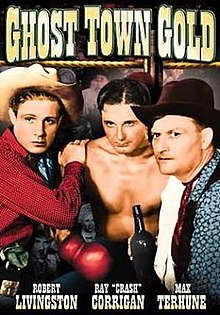Ray "Crash" Corrigan
| Ray "Crash" Corrigan | |
|---|---|

Theatrical release poster
(Corrigan in center) |
|
| Born |
Raymond Benard February 14, 1902 Milwaukee, Wisconsin, U.S. |
| Died | August 10, 1976 (aged 74) Brookings, Oregon, U.S. |
| Cause of death | Heart attack |
| Resting place | Inglewood Park Cemetery, California |
| Other names | Raymond Benard Ray Benard Ray Corrigan Crash Corrigan Gorilla |
| Years active | 1932–1958 |
| Spouse(s) | Elaine DuPont Rita Jane Smeal (?-1954) |
Ray "Crash" Corrigan (February 14, 1902 – August 10, 1976), born Raymond Benard (or Raymond Benitz, according to some sources), was an American actor most famous for appearing in many B-Western films. He also was a stuntman and frequently acted as silver screen gorillas using his own gorilla costumes.
In 1937 Corrigan purchased land in the Santa Susana Mountains foothills in Simi Valley and developed it into a movie ranch called "Corriganville". The movie ranch was used for location filming in film serials, feature films, and television shows, as well as for the performance of live western shows for tourists. Bob Hope later bought the ranch in 1966 and renamed it "Hopetown". It is now a Regional Park and nature preserve.
Corrigan's Hollywood career began as a physical fitness instructor and physical culture trainer to the stars. In the early 1930s he did stunts and bit parts in several films, billed as Ray Benard. Many of his early roles were in ape costumes, for example, as a gorilla in Tarzan and His Mate (1934) and an "orangopoid" in the first Flash Gordon serial. In 1936 Corrigan got his screen breakthrough with starring roles in two Republic serials, The Vigilantes Are Coming and in The Undersea Kingdom, which evoked memories of Universal's first "Flash Gordon" serial. His character in "The Undersea Kingdom" was known as Ray "Crash" Corrigan, and he adopted it as his screen name.
...
Wikipedia
